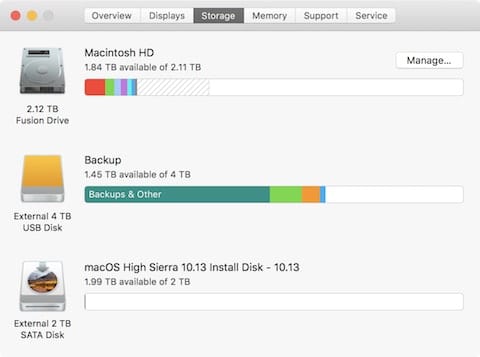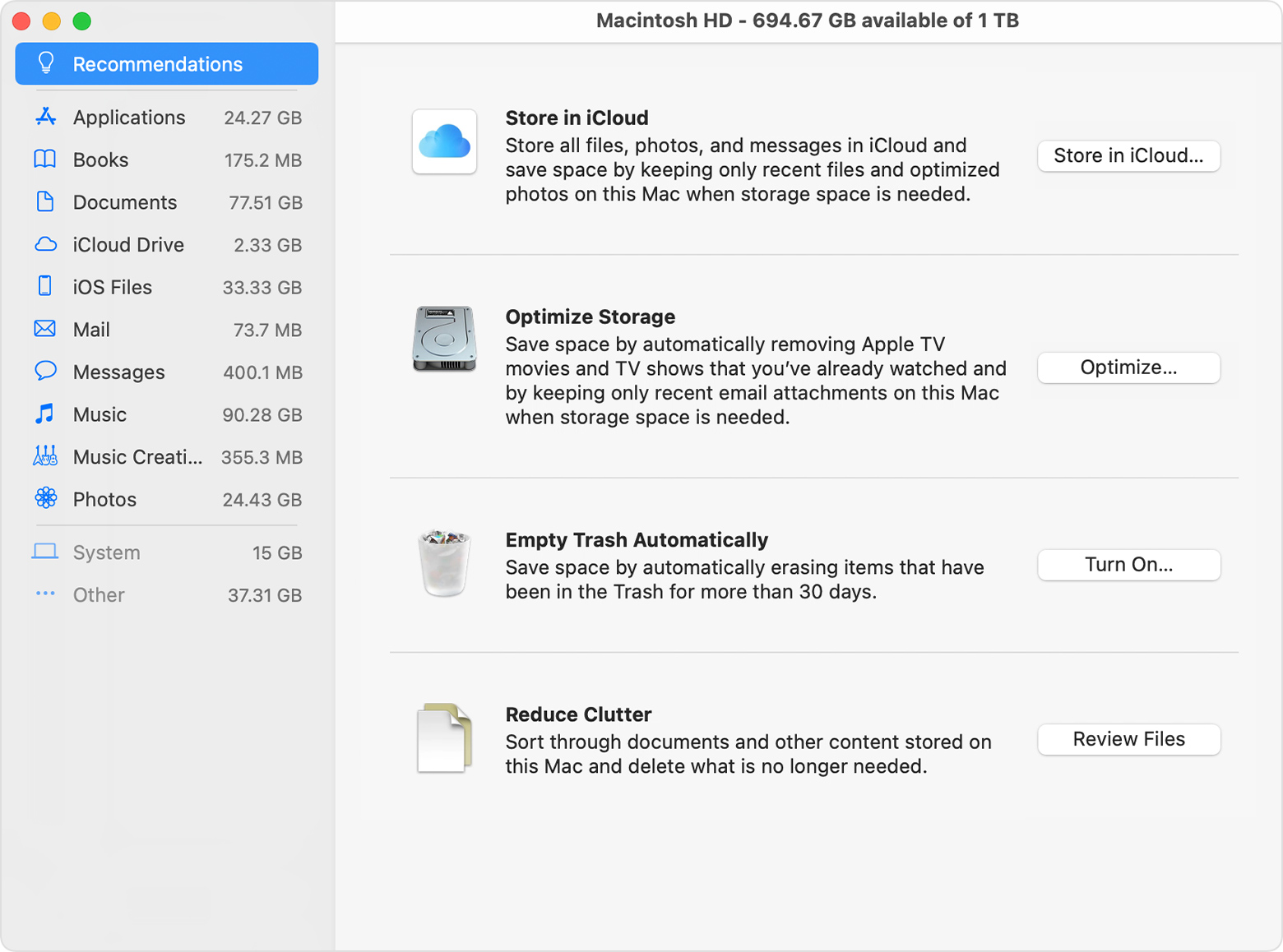Free up storage space on your Mac. Looks like no one’s replied in a while. To start the conversation again, simply ask a new question. User profile for user. If you want to reduce size of your VM(s), click on Parallels VMs Free Up Disk Space. Note: Visit this article to learn more how to clear cache from Mac. Identifying the contents of a virtual machine. The space taken by VM on Mac disk mostly belongs to operating system, programs and files in Windows.
The use of solid-state drives for storage in most Macs, and its stubborn refusal to fall in price means that most Macs produced in the last decade or so have less storage space than their predecessors. If you have, say a MacBook Air with 128GB of disk space, it will soon fill up. It’s important, then, to acquaint yourself with a few tricks to free up disk space, and that’s what we’ll show you here. Let’s get started and give your Mac’s disk a cleanup.
How to free up disk space using Apple’s built-in tools
Apple recognized that storage space was an issue for many users, so they introduced tools to help users optimize their space on Macs. Here’s how you can do that:
- Click the Apple menu and choose About this Mac.
- Select the Storage tab and press Manage.
- Click on Recommendations and review each of the options.
Tip
The first option allows you to store files, photos, and messages in iCloud and keep only recent files and optimized photos on your Mac. However, if you’d rather store messages and files on your machine, you can choose only to use iCloud for photos. We'll show you how to do that later in this article.
- Go through each of the headings on the left one-by-one. Click each and read the description in the main window then decide if you want to take the recommended action.
- When you're done, go to the System Information menu and press Quit System Information.
How To Free Up Space On Your Macbook Pro
1. Use iCloud Photo Library
iCloud Photo Library allows you to store the full resolution versions of your photos and videos in iCloud and keep a lower resolution, optimized versions on your Mac. You’ll need to download the full version when you want to edit a photo or video, but other than that there is no downside and you’ll save several gigabytes of space if you have lots of photos and videos. Here’s how to optimize your media files:
- Launch Photos.
- Click on the Photos menu and choose Preferences.
- Choose iCloud and tick the box labeled iCloud Photos.
- Now, check the box labeled Optimize Mac Storage.
- Close Preferences and quit Photos.
Shogun 2 total war fall of the samurai crack fix pirate games. Now, the high-quality versions of your photos and videos will be stored in iCloud.
2. Clear out junk and other files you don't need
Your Mac stores a ton of files that you probably don't even realize are there and that you don’t need. From language files for languages, you don’t use to temp files that should have been deleted long ago and libraries of applications you have removed.
It’s all still there causing your system to take up disk space on your Mac.
The easiest way to remove it quickly is to use an app that is designed for the purpose, like CleanMyMac X. It can free up several gigabytes of space with just a couple of clicks. Here’s how to free up space using its System Junk module as an example.
- Download CleanMyMac X, install, and launch the app.
- Choose the System Junk module in the sidebar.
- Press Scan.
- When it’s done, it will tell you how many GB of junk files it has found.
- Press Clean or Review Details if you want to check files that you delete first.
Additionally, CleanMyMac X features the Malware Removal module, which not many Mac cleaners have. It scans your Mac for all malware, including adware, keyloggers, viruses, and worms, and lets you remove those from your MacBook immediately. Facial age regression software.


3. Find out what is taking up space
It’s likely that as well as thousands of small files taking up space on your drive, there are a few very big files that you don’t need or can archive elsewhere. You can do that manually by following these steps.
- Open a new Finder window.
- Navigate to your Home folder.
- Press Command-F to start a new search.
- Click on the dropdown menu labeled Kind and choose Other.
- Scroll down to File Size and choose it.
Now, you can filter your files and delete the largest ones:
- In the menu next to that one, choose “is greater than” and choose a file size then type it in. Remember to select This Mac to get a full list of results.
- You’ll see the window fill up with files that meet the criteria.
- Click Save to save the search.
- Review the files and drag those you want to get rid of to the Trash or move them to an external drive.
If you’re looking for an easier way to find and delete large files, you can try doing it with CleanMyMac X. Choose Space Lens in the sidebar and press Scan. You'll see the categories listed in order of the space they occupy. Click any of them to see more details. Mouse over a bubble to see what it is and how much space it is taking up.
Explore the folders to find files that take a lot of space. If you find a file or folder you want to delete, check the box next to it in the middle window and press Remove. Make sure that you don’t need it or that you have another copy somewhere else.
Space Lens lets you quickly find the largest folders and see what’s stored inside of them. By starting with the files that are taking up most space, you will free up more room quickly.
4. Remove Mail attachments
Whichever email client you use, downloading attachments can soon take up lots of space on your boot disk. The good news is that if you use an IMAP client, like Apple’s Mail or Gmail, you can delete attachments safely, knowing that they will remain on the server if you need them at another time. That’s another job you can do manually. Just open the Downloads folder and clear out all old attachments.
5. Move your Music library
It used to be the case that one of the most effective ways to save space was to move your iTunes library folder to an external drive. As of macOS Catalina, iTunes no longer exists. However, its replacement, Music, still references a folder called iTunes, where it stores music you downloaded from the iTunes Store. If you still download music or play from local files, rather than stream it, you can move your collection to an external drive to save space.
How To Free Up Space On Your Mac Computer
- Go to ~/Music/iTunes (is your Home folder).
- Copy the iTunes Media folder to an external drive.
- Launch Music, click on the Music menu, and choose Preferences.
- Press Files, then Change.
- Navigate to the folder where you copied your iTunes Media.
- Press Ok.
- You can now quit Music and delete the iTunes Media folder from your Mac.

6. Uninstall applications
Most of us have lots of applications on our Macs that we never use. Getting rid of them can free up lots of space. However, just dragging the app icon to the Trash and emptying it won’t uninstall it completely. There will still be lots of files left behind.
There are two ways to uninstall an application properly: track down every file associated with the application and manually drag it to the Trash, or use a dedicated uninstaller. CleanMyMac X is one such tool.
- In the CleanMyMac X's sidebar, choose Uninstaller.
- Locate the application you want to uninstall (Tip: you can use the filters in the middle window to narrow down your search).
- When you find the application you want to delete, check the box next to it.
- Press Uninstall.
- Repeat steps 2-4 for each application you want to uninstall.
CleanMyMac X also removes all application data, which is usually left on your Mac unexposed. So, deleting any app with CleanMyMac X you automatically remove all files associated with the application and save up some space.
7. Compress folders
If there are folders of files you don’t want to trash or move, compressing them will save some space. Control-click the folder and choose Compress from the menu.
As you can see, there are lots of ways to save space on your Mac, without resorting to buying extra storage. Follow the steps above, and you could save several gigabytes.